Steven Krenn
BinauralFlow: A Causal and Streamable Approach for High-Quality Binaural Speech Synthesis with Flow Matching Models
May 28, 2025Abstract:Binaural rendering aims to synthesize binaural audio that mimics natural hearing based on a mono audio and the locations of the speaker and listener. Although many methods have been proposed to solve this problem, they struggle with rendering quality and streamable inference. Synthesizing high-quality binaural audio that is indistinguishable from real-world recordings requires precise modeling of binaural cues, room reverb, and ambient sounds. Additionally, real-world applications demand streaming inference. To address these challenges, we propose a flow matching based streaming binaural speech synthesis framework called BinauralFlow. We consider binaural rendering to be a generation problem rather than a regression problem and design a conditional flow matching model to render high-quality audio. Moreover, we design a causal U-Net architecture that estimates the current audio frame solely based on past information to tailor generative models for streaming inference. Finally, we introduce a continuous inference pipeline incorporating streaming STFT/ISTFT operations, a buffer bank, a midpoint solver, and an early skip schedule to improve rendering continuity and speed. Quantitative and qualitative evaluations demonstrate the superiority of our method over SOTA approaches. A perceptual study further reveals that our model is nearly indistinguishable from real-world recordings, with a $42\%$ confusion rate.
SoundVista: Novel-View Ambient Sound Synthesis via Visual-Acoustic Binding
Apr 08, 2025Abstract:We introduce SoundVista, a method to generate the ambient sound of an arbitrary scene at novel viewpoints. Given a pre-acquired recording of the scene from sparsely distributed microphones, SoundVista can synthesize the sound of that scene from an unseen target viewpoint. The method learns the underlying acoustic transfer function that relates the signals acquired at the distributed microphones to the signal at the target viewpoint, using a limited number of known recordings. Unlike existing works, our method does not require constraints or prior knowledge of sound source details. Moreover, our method efficiently adapts to diverse room layouts, reference microphone configurations and unseen environments. To enable this, we introduce a visual-acoustic binding module that learns visual embeddings linked with local acoustic properties from panoramic RGB and depth data. We first leverage these embeddings to optimize the placement of reference microphones in any given scene. During synthesis, we leverage multiple embeddings extracted from reference locations to get adaptive weights for their contribution, conditioned on target viewpoint. We benchmark the task on both publicly available data and real-world settings. We demonstrate significant improvements over existing methods.
ComplexDec: A Domain-robust High-fidelity Neural Audio Codec with Complex Spectrum Modeling
Feb 04, 2025



Abstract:Neural audio codecs have been widely adopted in audio-generative tasks because their compact and discrete representations are suitable for both large-language-model-style and regression-based generative models. However, most neural codecs struggle to model out-of-domain audio, resulting in error propagations to downstream generative tasks. In this paper, we first argue that information loss from codec compression degrades out-of-domain robustness. Then, we propose full-band 48~kHz ComplexDec with complex spectral input and output to ease the information loss while adopting the same 24~kbps bitrate as the baseline AuidoDec and ScoreDec. Objective and subjective evaluations demonstrate the out-of-domain robustness of ComplexDec trained using only the 30-hour VCTK corpus.
EARS: An Anechoic Fullband Speech Dataset Benchmarked for Speech Enhancement and Dereverberation
Jun 11, 2024



Abstract:We release the EARS (Expressive Anechoic Recordings of Speech) dataset, a high-quality speech dataset comprising 107 speakers from diverse backgrounds, totaling in 100 hours of clean, anechoic speech data. The dataset covers a large range of different speaking styles, including emotional speech, different reading styles, non-verbal sounds, and conversational freeform speech. We benchmark various methods for speech enhancement and dereverberation on the dataset and evaluate their performance through a set of instrumental metrics. In addition, we conduct a listening test with 20 participants for the speech enhancement task, where a generative method is preferred. We introduce a blind test set that allows for automatic online evaluation of uploaded data. Dataset download links and automatic evaluation server can be found online.
ScoreDec: A Phase-preserving High-Fidelity Audio Codec with A Generalized Score-based Diffusion Post-filter
Jan 22, 2024Abstract:Although recent mainstream waveform-domain end-to-end (E2E) neural audio codecs achieve impressive coded audio quality with a very low bitrate, the quality gap between the coded and natural audio is still significant. A generative adversarial network (GAN) training is usually required for these E2E neural codecs because of the difficulty of direct phase modeling. However, such adversarial learning hinders these codecs from preserving the original phase information. To achieve human-level naturalness with a reasonable bitrate, preserve the original phase, and get rid of the tricky and opaque GAN training, we develop a score-based diffusion post-filter (SPF) in the complex spectral domain and combine our previous AudioDec with the SPF to propose ScoreDec, which can be trained using only spectral and score-matching losses. Both the objective and subjective experimental results show that ScoreDec with a 24~kbps bitrate encodes and decodes full-band 48~kHz speech with human-level naturalness and well-preserved phase information.
Sounding Bodies: Modeling 3D Spatial Sound of Humans Using Body Pose and Audio
Nov 01, 2023


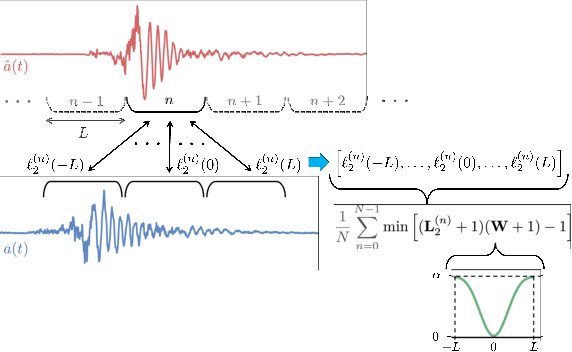
Abstract:While 3D human body modeling has received much attention in computer vision, modeling the acoustic equivalent, i.e. modeling 3D spatial audio produced by body motion and speech, has fallen short in the community. To close this gap, we present a model that can generate accurate 3D spatial audio for full human bodies. The system consumes, as input, audio signals from headset microphones and body pose, and produces, as output, a 3D sound field surrounding the transmitter's body, from which spatial audio can be rendered at any arbitrary position in the 3D space. We collect a first-of-its-kind multimodal dataset of human bodies, recorded with multiple cameras and a spherical array of 345 microphones. In an empirical evaluation, we demonstrate that our model can produce accurate body-induced sound fields when trained with a suitable loss. Dataset and code are available online.
Multiface: A Dataset for Neural Face Rendering
Jul 22, 2022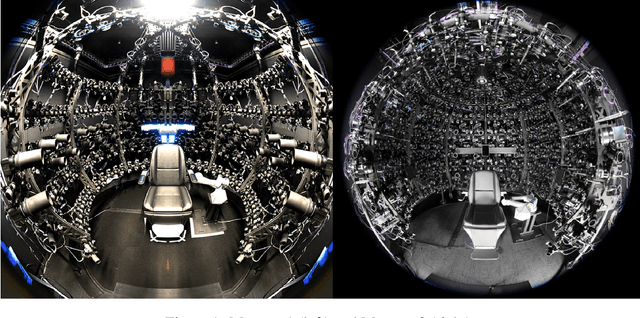

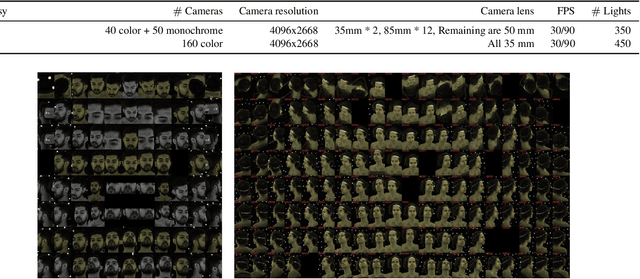
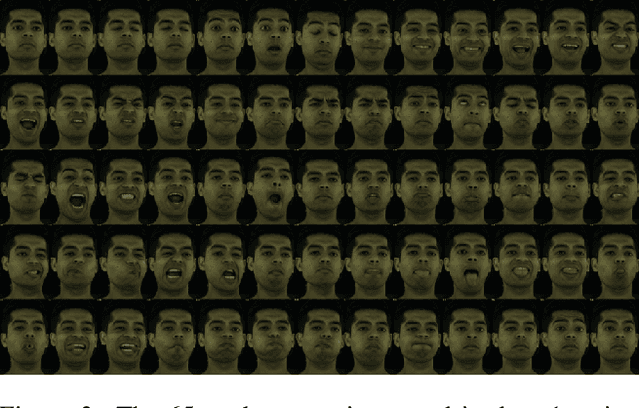
Abstract:Photorealistic avatars of human faces have come a long way in recent years, yet research along this area is limited by a lack of publicly available, high-quality datasets covering both, dense multi-view camera captures, and rich facial expressions of the captured subjects. In this work, we present Multiface, a new multi-view, high-resolution human face dataset collected from 13 identities at Reality Labs Research for neural face rendering. We introduce Mugsy, a large scale multi-camera apparatus to capture high-resolution synchronized videos of a facial performance. The goal of Multiface is to close the gap in accessibility to high quality data in the academic community and to enable research in VR telepresence. Along with the release of the dataset, we conduct ablation studies on the influence of different model architectures toward the model's interpolation capacity of novel viewpoint and expressions. With a conditional VAE model serving as our baseline, we found that adding spatial bias, texture warp field, and residual connections improves performance on novel view synthesis. Our code and data is available at: https://github.com/facebookresearch/multiface
Audio-Visual Speech Codecs: Rethinking Audio-Visual Speech Enhancement by Re-Synthesis
Mar 31, 2022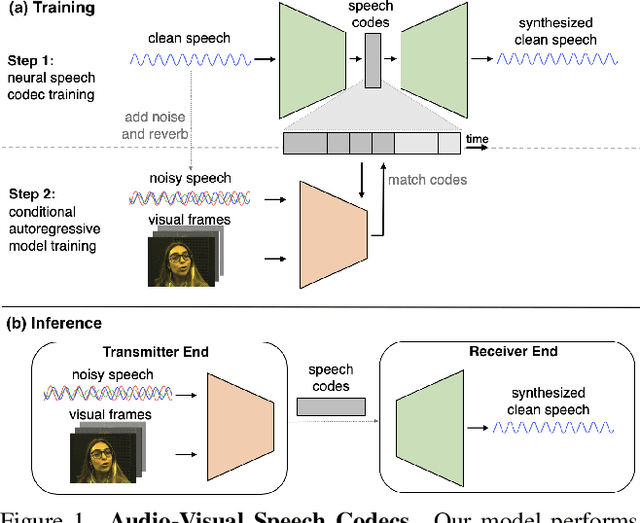

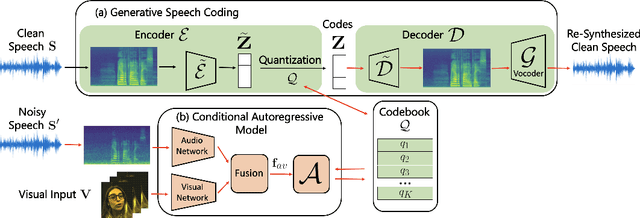

Abstract:Since facial actions such as lip movements contain significant information about speech content, it is not surprising that audio-visual speech enhancement methods are more accurate than their audio-only counterparts. Yet, state-of-the-art approaches still struggle to generate clean, realistic speech without noise artifacts and unnatural distortions in challenging acoustic environments. In this paper, we propose a novel audio-visual speech enhancement framework for high-fidelity telecommunications in AR/VR. Our approach leverages audio-visual speech cues to generate the codes of a neural speech codec, enabling efficient synthesis of clean, realistic speech from noisy signals. Given the importance of speaker-specific cues in speech, we focus on developing personalized models that work well for individual speakers. We demonstrate the efficacy of our approach on a new audio-visual speech dataset collected in an unconstrained, large vocabulary setting, as well as existing audio-visual datasets, outperforming speech enhancement baselines on both quantitative metrics and human evaluation studies. Please see the supplemental video for qualitative results at https://github.com/facebookresearch/facestar/releases/download/paper_materials/video.mp4.
 Add to Chrome
Add to Chrome Add to Firefox
Add to Firefox Add to Edge
Add to Edge